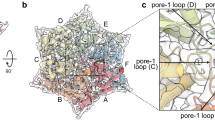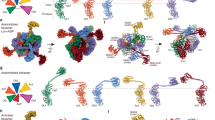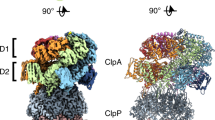Abstract
α-LYTlC protease, an extracellular serine protease of Lysobacter enzymogenes 495 , is synthesized as a pre-pro-protein1. Previously it has been shown that when expressed in Escherichia coli, the protein is autocatalytically processed in the periplasmic space, and that the functional protease domain accumulates extracel-lularly2. Engineered proteins lacking the 166 amino-acid pro-region were enzymatically inactive and remained cell-associated2. By independently expressing the pro- and protease domains in vivo, evidence is provided here that direct covalent linkage is not required for production of active protease. We postulate that the pro-region acts as a template to promote the folding of the protease domain into an active configuration. Our results, combined with recent experiments on the evolutionarily unrelated subtilisin E (ref. 3), suggest that the ability of the pro-region of these bacterial proteases to facilitate folding of their protease domains is not a curiosity of a single system, but may reflect a general property of extracellular bacterial serine proteases.
This is a preview of subscription content, access via your institution
Access options
Subscribe to this journal
Receive 51 print issues and online access
$199.00 per year
only $3.90 per issue
Buy this article
- Purchase on Springer Link
- Instant access to full article PDF
Prices may be subject to local taxes which are calculated during checkout
Similar content being viewed by others
References
Silen, J. L., McGrath, C. N., Smith, K. R. & Agard, D. A. Gene 69, 237–244 (1988).
Silen, J. L., Frank, D., Fujishige, A., Bone, R. & Agard, D. A. J. Bact. 171, 1320–1325 (1989).
Zhu, X., Ohta, Y., Jordan, F. & Inouye, M. Nature 339, 483–484 (1989).
Anfinsen, C. B. Proc. natn. Acad. Sci. U.S.A. 47, 1308–1314 (1961).
Creighton, T. E. J. phys. Chem. 89, 2452–2459 (1985).
Ikai, A., Fish, W. & Tanford, C. J. J. molec. Biol. 145, 265–280 (1973).
Ikemura, H., Takagi, H. & Inouye, M. J. biol. Chem. 262, 7859–7864 (1987).
Ghrayeb, J. et al. EMBO J. 10, 2437–2422 (1984).
Kaplan, H., Symonds, V. B., Dugas, H. & Whitaker, D. R. Can. J. Biochem. 48, 649–658 (1970).
Fujinaga, M., Delbaere, L. T. J., Brayer, G. D. & James, M. N. G. J. molec. Biol. 183, 479–502 (1985).
Jacobs, M., Eliasson, M., Uhlen, M. & Flock, J. I. Nucleic Acids Res. 13, 8914–8926 (1985).
Shimada, H. et al. Biotechnology 2, 75–85 (1985).
Stahl, M. L. & Ferrari, E. J. Bact. 158, 411–418 (1984).
Takagi, M., Imanaka, T. & Aiba, S. J. Bact. 163, 824–831 (1985).
Vasantha, N. et al. J. Bact. 159, 811–819 (1984).
Wells, J. A., Ferrari, E., Henner, D. J., Estell, D. A. & Chen, E. Y. Nucleic Acids Res. 11, 7911–7925 (1983).
Yang, M. Y., Ferrari, E., & Henner, D. J. J. Bact. 160, 15–21 (1984).
Henderson, G., Krygsman, P., Liu, C. J., Davey, C. C. & Malek, L. T. J. Bact. 169, 3778–3784 (1987).
Hemmingsen, S. et al. Nature 333, 330–334 (1988).
McMullin, T. W. & Hallberg, R. L. Molec. cell. Biol. 8, 371–380 (1988).
Author information
Authors and Affiliations
Rights and permissions
About this article
Cite this article
Silen, J., Agard, D. The αlytic protease pro-region does not require a physical linkage to activate the protease domain in vivo. Nature 341, 462–464 (1989). https://doi.org/10.1038/341462a0
Received:
Accepted:
Issue Date:
DOI: https://doi.org/10.1038/341462a0
This article is cited by
-
Intramolecular chaperone-mediated secretion of an Rhs effector toxin by a type VI secretion system
Nature Communications (2020)
-
Cloning, expression, and characterization of serine protease from thermophilic fungus Thermoascus aurantiacus var. levisporus
The Journal of Microbiology (2011)
-
Unfolding Studies of Escherichia coli Maltodextrin Glucosidase Monitored by Fluorescence Spectroscopy
Journal of Biological Physics (2008)
-
Unfolding and Refolding of Bovine α-Crystallin in Urea and Its Chaperone Activity
The Protein Journal (2007)
-
Unfolded conformations of α-lytic protease are more stable than its native state
Nature (1998)
Comments
By submitting a comment you agree to abide by our Terms and Community Guidelines. If you find something abusive or that does not comply with our terms or guidelines please flag it as inappropriate.



